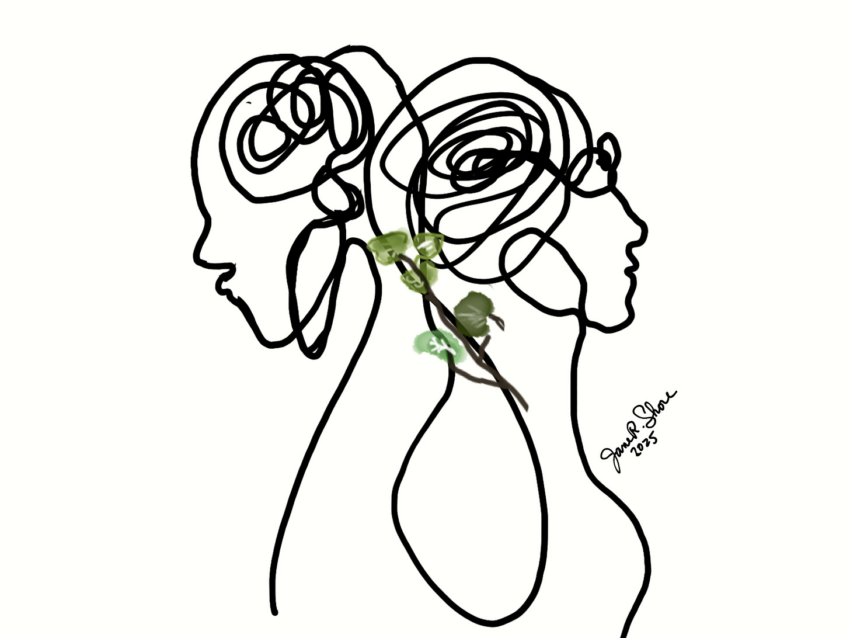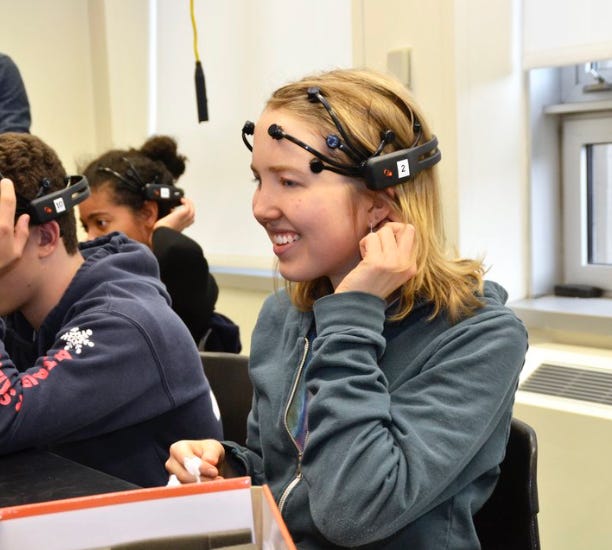Hi friends,
Does anyone out there remember that commercial for Reese’s Peanut Butter Cups where two strangers are walking down the street, one eating chocolate, the other peanut butter (questionable?) listening to Walkmen (*!) and they collide on a busy sidewalk? (Classic)
As they connect one says, “You got your peanut butter on my chocolate!” And the other replies,“You got your chocolate in my peanut butter!” (I never thought about how weird it is to walk down the street eating a tub of peanut butter before.)
And of course, they both pause, taste the combo… and it’s Reeses, so…it’s good.
For some reason, this commercial is what I picture as I read the latest research on brain synchrony. Brains are wild. And the more we study them, the more we realize how much we don’t know.
Traditionally, neuroscientists have studied how a single brain reacts to a word, a stimulus, a screen. But humans aren’t built for isolation, we’re wired for connection, right? And learning more about connected learning is fueling me.
So this shift right now brings brain science in line with People-Based Learning.
The Big Idea
Collective neuroscience, as it’s increasingly called, is now revealing why People-Based Learning is so essential. Deep learning happens between us.
(Brain wave art)
An early and consistent finding in this field is that when people interact, whether talking, learning, or just sharing attention, their brain waves begin to synchronize.
You might have heard of mirror neurons? Neural coupling? Corresponding brain regions start to fire together, creating mirrored rhythms, like dancers moving in sync.
And so it’s clear that the visual and auditory regions light up in similar ways between and among those who are learning in engaged and connected ways.
BUT the really exciting stuff happens in meaning-making regions of the brain. Higher-order areas that interpret, imagine, and reflect begin to echo each other, too.
The feeling of “being on the same wavelength” with someone is REAL.
And it’s measurable. (Whhaaaaaat!?)1
Recent studies by NYU neuroscientist Dr. Suzanne Dikker studied students wearing portable EEG caps during classes to read brain waves while learning together. ⬇️
The results are stunning. Can I say research is stunning? I think yes. ✔️
When students felt socially connected to their teacher and each other, their brainwaves literally synced up.
More synchrony = more engagement.
More engagement = deeper learning.
People-Based Learning=deeper learning.
That’s a scientific way of saying what PeBL is all about: relationships are not just nice to have; they’re central to how we learn.2
These syncing patterns show up across settings:
-
In classrooms: Engaged students begin to mirror the teacher’s brain activity.
-
In audiences: Listeners’ brainwaves align with performers’.
-
In relationships: Couples & friends show more synchrony than acquaintances.
Synchrony even prepares us for interaction. It signals belonging. And it may explain why isolation is so damaging not just emotionally, but cognitively.
In People-Based Learning, we call this the relational field: the invisible web that holds a group, shapes how we show up, and amplifies what’s possible.
Friends! Geek out with me!!!
Dr. Suzanne Dikker is among the guests who have generously agreed to be in conversation with me this fall as a part of the People-Based Learning Project Human Library Series. I am hosting conversations with the researchers, storytellers, learners, leaders, and other contributors to the book and they will be available to School of Thought subscribers. I hope it makes ideas come alive even more.
Making Big Ideas Usable
Want to try a tiny experiment?
Next time you’re in a group, at work, school, a dinner table, wherever, try this:
Before diving into the task, pause for a moment of mutual presence.
It can be as simple as:
-
a check-in question,
-
a moment of eye contact,
-
a shared breath or laugh.
It doesn’t have to be profound. It just has to be shared.
Then notice: Do ideas move more freely? Do people listen more closely? Does something, maybe even your brain, shift?
You don’t need an EEG cap to tell you that something is happening. You’ll feel it.
Because connection changes how we think, what we remember, and whether we care.
📚 For Further Learning
-
Suzanne Dikker’s Lab and the Brainwaves in the Classroom study
-
Nice, light article on 5 ways to use this research on brain synchrony
-
Super interesting article about when talking brings you relief, it might be because your brain waves are syncing with the person listening.
If you’ve been reading and enjoying School of Thought for a while, now is a great time to get access to artful resources and recommendations.
With curiosity,
Jane
P.S. Two years ago (July 10, 2023) I had brain surgery. All is well now (truly), and the whole experience only deepened my awe for pretty much everything, but especially the brain. As my younger son wrote in a summer back to school email to his teachers, “My mom had brain surgery, but it was no big deal.” Which is both hilarious and, somehow, exactly right.
Criticism about this work has centered on the idea that the synchrony could just be that they are in the same environment experiencing the same things. To test this criticism, scientists from the University of Pittsburgh and Temple University designed an experiment in which participants worked differently on a focused task: completing a puzzle(opens a new tab). The volunteers either assembled a puzzle collaboratively or worked on identical puzzles separately, side by side. While there was some interneural synchrony between puzzlers working independently, it was much greater in those who collaborated.
And if you are wondering about in person vs. virtual, there are studies on this, too. In one study, published in late 2022, Linoy Schwartz and his colleagues measured the brain activity of mothers and their preteen children when they communicated through online video. The pairs’ brains synchronized much less on video than when they talked in person. Such poor interbrain synchrony online could help explain why Zoom meetings tend to be so tiring, according to the study’s authors.
Click this link for the original source of this article.
Author: Dr. Jane R. Shore
This content is courtesy of, and owned and copyrighted by, https://schoolofthought.substack.com and its author. This content is made available by use of the public RSS feed offered by the host site and is used for educational purposes only. If you are the author or represent the host site and would like this content removed now and in the future, please contact USSANews.com using the email address in the Contact page found in the website menu.












